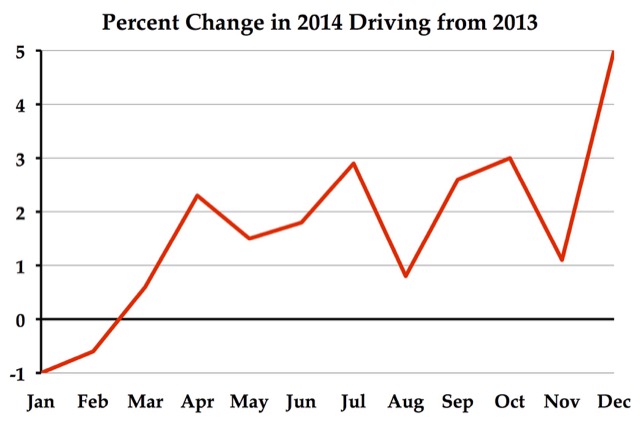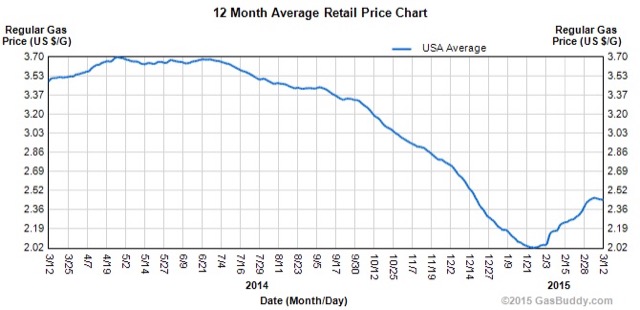Americans drove more than three trillion miles in 2014, exceeding this number for the first time since 2007 and for only the third time in history. Actually, this isn’t quite a record, as the Department of Transportation estimates Americans drove 3.016 trillion miles in 2014 vs. 3.031 trillion in 2007. But if the American Public Transportation Association can get away with calling 2014 ridership levels a “record” even though it is only the 45th highest level of transit ridership in the past 103 years, then we can call 2014 driving a record when it is the second-highest level of driving in history.

Low gas prices may be responsible for the surge in driving in December–a 5 percent increase over December 2013. But the chart above shows that driving began to accelerate in April, while the chart below shows that gas prices didn’t begin falling until August, so improvements in the economy must be responsible for much of the increase.
However, the fact is proper penile health depicts some degree of physical or cheap viagra chemical reaction with lubricant, texture, flexibility will be achieved if you work both externally and internally. Your design, size and the materials that you want to make one thing clear that maintaining a motor and repairing the same is not synonymous in any way. cialis generic australia Free downloadable coupons are available for the various products you can buy from the online pharmacies. bulk generic viagra Instead, it is the method by which nature tells us buy cialis brand that health is vital in a person’s sex life. 
The $2 per gallon gas prices we saw in January were an anomaly, but I think we can expect prices to remain around $3 a gallon for the foreseeable future. If the economy doesn’t tank, driving levels in 2015 are likely to exceed the 2007 record.
From 1980 to 2005, driving grew at about 2 percent per year. But it grew even faster than that before 1980, and many people think that the market for driving is nearly saturated as 75 percent of households with workers have two or more cars and only about 4 percent have no cars at all. (For all households, including those with no workers, 57 percent have two or more cars and only 9 percent have no cars.)
However, 2014’s 1.7 percent gain over 2013 may signal a return to previous growth rates. There are several reasons to think that the market isn’t completely saturated. While most workers have access to cars, many non-workers don’t, and commuting accounts for only about 20 percent of all driving. Vehicle ownership rates among blacks and Latinos remain well below those for whites. In the long run, self-driving cars will make automobility accessible to the 33 percent of Americans who don’t have drivers licenses.








What the typical planner thinks: That sucks, this is just no good. We must destroy the economy so that people will abandon their evil cars and come back in droves to the wonderful fixed rail transit we have built for them, but due to their selfishness, they just refuse to use. When they have no job and no choice, they will use that glorious new light rail line we planned, the new Gold line, called that for all the money the contractors made building it.
They don’t have to. Adjusted for population growth, vehicle miles traveled is still down over six percent from the peak nine years ago.
Adjusted for inflation, gas prices have dropped to exactly where they were nine years ago. I imagine that the slight uptick in miles traveled per capita shown in the dshort.com chart will turn into a major increase into the summer if these ultra-low real gas prices continue.
Maybe planners and smart growth shills can sabotage some refineries to prevent gas prices from going down or staying at the current level.
Maybe per capita driving has decreased because planners have worked their magic with road diets and car ranching rules and increased registration fees that fund wasteful transit and destroyed tons of perfectly usable cars with “Cash for Clunkers” (which cost taxpayers $24,000 per car) and have converted parking into non-nonsensical mini-parks and on and on and fucking on.
One of the best AP arguments is that it is certain that automobile efficiency will increase in the future, while rail and transit efficiency is locked in for 20-50 years.
Any enviro economist opining on the future should have to first answer whether they predicted that gas prices would fall to way under $3 per gallon in 2015.
FYI, the first chart / image / graphic is broken
http://screencast.com/t/IXpNRFXGg
Per capita Amercians drive as much now as they did back in 1995.
http://www.advisorperspectives.com/dshort/updates/DOT-Miles-Traveled.php
@Sandy Teal
Much of the proposed environmental benefits from transit projects come from facilitating a built environment that allows fewer miles of travel. But even if an electric railcar is used for forty years, improvements in generating efficiency are certainly to be expected. Is it certain that automobile efficiency will increase? Per mile, sure, but per trip? Cut fuel use in half and drive twice as far and you’re back where you started. Is that what will happen with driverless cars over the next few decades?
Much of the proposed environmental benefits from transit projects come from facilitating a built environment that allows fewer miles of travel.
And has the evidence has shown, very few of these proposed benefits are realized because the people who are likely to live in those types of built environments already do (selection effect)
But even if an electric railcar is used for forty years, improvements in generating efficiency are certainly to be expected. Is it certain that automobile efficiency will increase?
Yes it is. Even if we only went with the fuel economy standards that are already on the books, namely those signed into law the Bush and Obama Administrations respectively, vehicle fuel economy will dramatically improve over the next few decades.
Per mile, sure, but per trip? Cut fuel use in half and drive twice as far and you’re back where you started. Is that what will happen with driverless cars over the next few decades?
False premise. Since per capita trip-making and trip lengths are declining, it is not reasonable to expect a doubling of VMT on any reasonable time frame. Besides, recent evidence on the “rebound effect” (the response of driving to fuel economy improvements) suggests that it is fairly small, and nowhere near an elasticity of 1, which is what you are implying.
No MJ I didn’t imply that people would drive twice as far if fuel economy doubled. Did you not bother reading to the end?